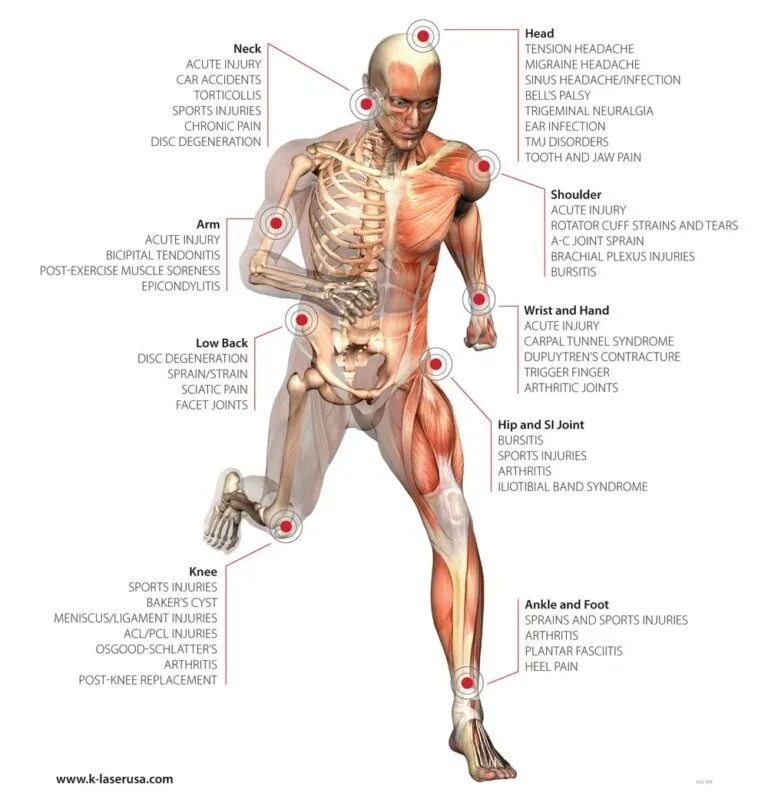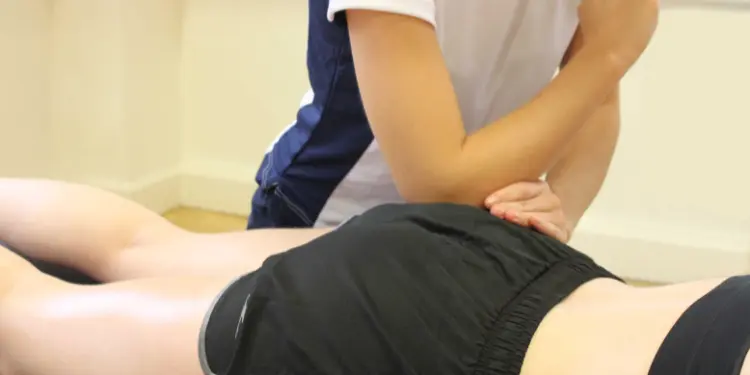Trigger points and sciatica can lead to significant discomfort, making daily activities challenging. Sciatica occurs when the sciatic nerve gets irritated, causing pain that travels from your lower back down your leg. Trigger points are tight spots in your muscles that can also cause pain. This article will show you how to quickly relieve pain from sciatica and trigger points using stretches, massages, trigger point injections, heat and ice therapy, lifestyle changes, and more.
Key Takeaways
- Understanding what trigger points and sciatica are can help you find the right relief methods.
- Stretches like the piriformis stretch and hamstring stretch can help ease sciatica pain.
- Massage techniques such as myofascial release can target painful areas and provide relief.
- Receiving trigger point injections to break up the adhesions caused by trigger points.
- Using heat and ice therapy can reduce inflammation and relax muscles.
- Making lifestyle changes like regular exercise and good posture can prevent sciatica flare-ups.
Understanding Trigger Points and Sciatica

What Are Trigger Points?
Trigger points are tight knots in muscles that can cause pain. These spots are often tender and can be felt as a tight, tender spot on your lower back muscles. Trigger points can develop from muscle overuse, stress, or injury.
How Trigger Points Affect Sciatica
Trigger points can irritate the sciatic nerve, leading to sciatica pain. These conditions can lead to pain that travels the entire length of the sciatic nerve, beginning in the lower back, moving through the hips and buttocks, and continuing down into each leg, often causing discomfort that can be felt from the spine to the feet.
Common Symptoms of Sciatica
Sciatica is characterized by pain that extends from the lower back down through the buttocks and legs. This pain can vary from a mild, persistent ache to a sharp, burning sensation. Additionally, some individuals may experience numbness, tingling, or muscle weakness in the affected leg.
Effective Stretches for Sciatica Relief
Piriformis Stretch
- Position: Sit on a chair and cross the leg with sciatica pain over the knee of your other leg.
- Action: Rotate your torso to the right, positioning your left elbow on the outside of your right knee. Look over your right shoulder to enhance the stretch.
- Hold: Maintain the stretch for 15-30 seconds.
- Repetition: Perform 3 times for each leg.
Seated Spinal Twist
- Position: Sit on the floor with your legs stretched out in front of you. Bend your right knee and position your right foot on the outside of your left knee.
- Action: Twist your torso to the right, placing your left elbow on the outside of your right knee. Look over your right shoulder to enhance the stretch.
- Hold: Keep this position for 15-30 seconds.
- Repetition: Repeat on the opposite side, and perform 3 times for each side.
Hamstring Stretch
- Position: Lie on your back, with one leg bent and the other extended straight up. Support the raised leg with both hands behind your thigh.
- Action: Gently pull your straight leg towards your head, ensuring you keep it straight. Feel the stretch along the back of your leg.
- Hold: Sustain this stretch for 15-30 seconds.
- Repetition: Do this 3 times for each leg.
Gentle stretching exercises can be effective to ease the pain of sciatica. If it gets worse or doesn’t improve in a few weeks, see your doctor.
Massage Techniques to Alleviate Sciatica Pain

Myofascial Release
Myofascial release also helps to warm up the muscles, preparing them for more intensive massage techniques. Stiff muscles and joints can restrict movement, so myofascial release helps pinpoint the areas that need the most attention. It’s found to treat piriformis syndrome, which often contributes to sciatica effectively.
Stand at the patient’s waist and face their feet to perform myofascial release for sciatica pain. Place your hand on the lower back with an open palm angled at a 45° to the skin, and gently glide it down towards the knee joint using minimal pressure.
Myofascial release also helps warms up the muscles for more intensive massage techniques.
Self-massage tip: Lift your hips onto a foam roller and roll backward across it from your glutes to your knee.
Sacrum Pressure Relief
The sacrum is a small, triangular bone situated at the base of your spine. Position a soft fist on the sacrum, followed by a gentle press of the heel of your other hand into the skin below, stretching and separating the gluteus maximus muscle.
Repeat this motion a few times until you feel some tension release across the gluteus maximus. Take care to avoid pressing directly on the sciatic nerve; if the patient feels any tingling or numbness, ask them to inform you right away.
Self-massage tip: You can try this technique on your own. Stand and place a fist on your sacrum, then with your other hand, stretch the glutes as outlined above.
Gluteus Minimus Massage

The gluteus minimus muscle can cause discomfort that mimics sciatica. So, massaging this muscle is an excellent way to relieve pain in this area.
Massage therapy is an effective solution for relieving pressure on the sciatic nerve and providing sciatica pain relief. While it may not provide a permanent cure for sciatica, it is often recommended as a preliminary step before pursuing medical treatments like steroid injections.
Massage offers a natural way to relieve sciatica pain and promote healing, even if the pain is making it difficult to walk or move. However, Pressing on the sciatic nerve can worsen irritation, making it crucial to use the right massage techniques for effective pain relief.
Utilizing Heat and Ice Therapy

Benefits of Heat Therapy
Using heat therapy is a simple and efficient way to alleviate sciatica discomfort. Applying heat helps relax tight muscles, which can reduce pressure on the sciatic nerve. It also boosts blood flow, promoting healing. You can use a heating pad, hot water bottle, or take a warm bath. Just make sure the heat source isn’t too hot to avoid burns.
When to Use Ice Therapy
Ice therapy is great for reducing inflammation and numbing the painful area. This can provide immediate relief, especially during the first 48-72 hours of a sciatica flare-up. Wrap a cold pack or frozen peas in a towel and hold it on the affected area for 15-20 minutes, repeating every couple of hours. Be cautious not to put ice directly on your skin to prevent the risk of ice burns.
Alternating Heat and Ice for Optimal Relief
For some people, alternating between heat and ice therapy works best. Use ice first to decrease inflammation, followed by heat to soothe and relax the muscles. Listen to your body and adjust as needed. This method can offer significant relief from sciatica pain, but remember, it’s part of a broader treatment plan. If your symptoms persist, make sure to consult a healthcare professional.
Professional Trigger Point injections
If pain continues and does not resolve after trying self remedies, trigger point injections done by a licensed professional such as our medical staff at Waters Edge Medical Clinic can eliminate the adhesions, knots and problem.
Lifestyle Adjustments to Prevent Sciatica Flare-Ups
Incorporating Regular Exercise
Regular exercise is key to preventing sciatica. Strengthening the muscles around your spine can alleviate pressure on the sciatic nerve. Focus on a combination of aerobic activities for optimal results, like walking or swimming, and strength training exercises. Remember, consistency is crucial.
Maintaining Proper Posture
Maintaining proper posture is crucial for spinal alignment and relieving undue pressure on the sciatic nerve. Here are some tips:
- At Work: Use a chair that supports your lower back. Ensure the height is adjusted so that your feet are flat on the floor and your knees are in line with your hips.
- At Home: Choose seats with good lumbar support or use a cushion behind your lower back while sitting.
- On the Go: Wear shoes with good support and avoid high heels.
Ergonomic Workspaces
Creating an ergonomic workspace can significantly reduce sciatica pain. Here’s how:
- Monitor Height: Position your computer screen at eye level to prevent neck and back strain.
- Frequent Breaks: Stand, stretch, or walk briefly every 30 minutes to avoid prolonged sitting.
- Ergonomic Devices: Consider using a standing desk or ergonomic mouse and keyboard.
Small changes to your daily habits can significantly reduce the stress on your sciatic nerve and prevent future flare-ups.
By incorporating these lifestyle changes, you can manage and even prevent sciatica pain effectively.
Seeking Professional Help for Sciatica
When to See a Doctor
If your sciatica pain lasts more than a week despite self-care, or if you have severe symptoms like significant loss of movement or worsening pain, it’s time to seek professional help. Immediate relief may require the expertise of healthcare providers who specialize in pain relief for sciatic nerve issues. Waters Edge Medical Clinic specializes in lower back and sciatic pain. Our professionals use regenerative medicine to not only relieve the problem but also fix and regenerate the problem.

Benefits of Physical Therapy
Physical therapy can be a game-changer for sciatica sufferers. A trained therapist can develop a personalized treatment plan that includes special exercises to gain strength and learn to move in ways that help prevent pain. Research shows that early referral to physical therapy can lead to better long-term results.
Exploring Alternative Treatments
There are various alternative treatments available for sciatica, including:
- Myofascial release: This technique targets sensitive areas known as trigger points to alleviate pain.
- Acupuncture: Inserting fine needles into targeted points on the body to reduce pain.
- Chiropractic care: Adjustments to the spine to adjust alignment to ease pressure on the sciatic nerve.
Consulting a trained professional ensures a correct diagnosis, a tailored and effective treatment plan, and the prevention of potential complications, safeguarding your health and well-being.
Home Remedies for Immediate Sciatica Relief
Using Over-the-Counter Pain Relievers
Over-the-counter pain relievers can offer fast relief from sciatica pain. Nonsteroidal anti-inflammatory drugs (NSAIDs) like ibuprofen or aspirin help reduce inflammation and alleviate discomfort. Always follow the dosage instructions on the label and for any concerns, seek advice from a healthcare professional.
Applying Topical Analgesics
You can apply topical analgesics, such as menthol- or capsaicin-containing creams or gels, directly to the affected area. These products work by numbing the skin and reducing pain signals. They are a convenient option for those tired and frustrated with dealing with sciatic pain.
Gentle Yoga Poses
Incorporating mild yoga poses into your routine can support the stretching and strengthening of the muscles near the sciatic nerve.. Poses like the child’s pose, cat-cow stretch, and pigeon pose can be particularly effective. Remember to move slowly and pay attention to your body to avoid further injury.
For those suffering from sciatica pain, understanding the underlying causes and implementing targeted relief strategies can transform daily living.
Dealing with sciatica pain can be tough, but there are simple home remedies that might help you feel better fast. From stretching exercises to using ice packs, these methods can provide quick relief. Want to learn more about how to ease your sciatica pain at home?
Conclusion
Dealing with trigger points and sciatica pain can be tough, but there are many ways to find relief quickly. By using stretches, exercises, and massage techniques, you can ease the pain and get back to your daily activities. Remember, it’s important to stay active and avoid long periods of rest. If the pain persists, don’t hesitate to seek help from a healthcare professional. With the right approach, you can manage your pain and improve your quality of life.
Frequently Asked Questions

What are trigger points?
Trigger points are tight spots in your muscles W\which may result in pain in different parts of your body. They are commonly known as muscle knots and can be very sensitive when touched.
How do trigger points affect sciatica?
When trigger points press on the sciatic nerve, they can cause pain that travels from your lower back down to your legs. This can make sciatica symptoms worse.
What are common symptoms of sciatica?
Common symptoms of sciatica include sharp pain, numbness, and tingling that begin in your lower back and travels down your leg. You might also feel weakness in the affected leg.
Can stretching help relieve sciatica pain?
Yes, stretching can help relieve sciatica pain by loosening tight muscles that may be pressing on the sciatic nerve. Stretches like the piriformis stretch and hamstring stretch are often recommended.
When should I see a doctor for sciatica?
You should see a doctor if your sciatica pain is severe, lasts more than a few weeks, or is accompanied by other symptoms like loss of bladder or bowel control. Consulting with a doctor can help pinpoint the cause and guide you to the right treatment.
Are there home remedies for immediate sciatica relief?
Yes, there are several home remedies for immediate sciatica relief, including using over-the-counter pain relievers, applying heat or ice packs, and doing gentle stretches or yoga poses.
If you have any additional questions, or if you would like to receive a free consultation and trigger point analysis please contact our office at Waters Edge Medical Clinic 1700 66th St. N. Suite 304 St. Petersburg, Fl. 33710. 727-550-0855.

